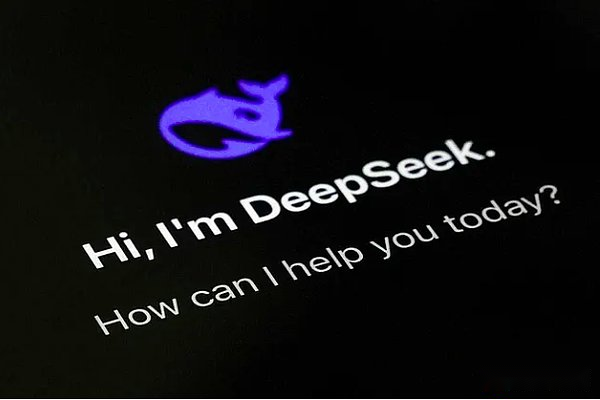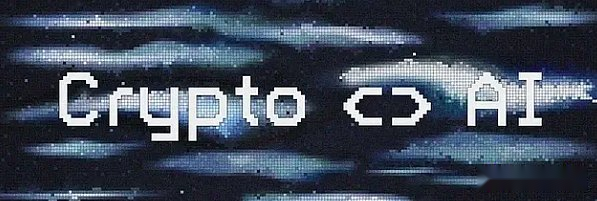
Author: Zeke, researcher at YBB Capital
1. AI is inevitable, but what about Crypto x AI?
At the beginning of 2025, a “nuclear bomb” dropped by DeepSeek, a quantitative development of Huanfang, shocked the AI world.China only used 2,048 NVIDIA H800 GPUs to train AI models, which cost 5.58 million US dollars (about one-tenth of the cost of Meta) to face GPT-4, Llama 3.1, etc. in benchmark tests such as MMLU and GPQA, and even in complex situations.The fields of reasoning, Chinese semantic understanding are slightly better.Although the United States has implemented chip blockade on China for many years, DeepSeek’s computing power has greatly broken the United States’ monopoly. China has embarked on a technological path that suits its national conditions but is not inferior to the world’s first-class model. This kind of open source, low-cost,The practice of homogeneity has broken through the US’s computing defense at an astonishing speed.
 Over the years, Chinese technology products have lagged behind in performance and have been labeled as cheap and low-end. I believe this is the intuitive impression of many people on Chinese Internet companies.But DeepSeek is different. Putting aside the subjective feelings of whether it surpasses ChatGPT, this matter is frequently mentioned by the American political circle and technology circle, which itself illustrates the problem.It is obvious that China has now transformed from a technology follower to a challenger, and its global chain effect is very far-reaching.
Over the years, Chinese technology products have lagged behind in performance and have been labeled as cheap and low-end. I believe this is the intuitive impression of many people on Chinese Internet companies.But DeepSeek is different. Putting aside the subjective feelings of whether it surpasses ChatGPT, this matter is frequently mentioned by the American political circle and technology circle, which itself illustrates the problem.It is obvious that China has now transformed from a technology follower to a challenger, and its global chain effect is very far-reaching.
While the first thing that was affected was my wallet, which could be attributed to misjudgment on the development of traditional AI, I still want to share my views, especially about the impact of DeepSeek on the crypto industry.
1. NVIDIA is the biggest loser in this incident.
First, the demand for AI computing power is questioned; second, CUDA, NVIDIA’s unified software and hardware computing architecture, was bypassed.If you are familiar with the field of AI, you must know that CUDA is an important cornerstone for promoting the development of modern AI.When using NVIDIA GPUs, big model developers generally rely on CUDA to complete their work.CUDA has low technical requirements for developers because it has pre-encapsulated functions, and developers don’t have to worry about too much details, but this comes at the expense of execution efficiency.
Since CUDA is a general programming framework, it limits the flexibility of model training.DeepSeek’s solution is to directly use PTX (the intermediate instruction set framework designed by NVIDIA for GPUs) to bypass the hardware’s limitations on training speed, thereby shortening training time.Other models take 10 days to train, while DeepSeek takes only 5 days to complete.This also means that if DeepSeek plans to adapt to Chinese domestic GPUs in the future, the hardware adaptation process will be more seamless, which is expected to shake NVIDIA’s dominant position in the AI chip market.(This paragraph is excerpted from the report of South Korea Future Asset Securities on the DeepSeek training process)
In addition to the possibility of NVIDIA’s stock price falling and severely impacting the crypto market closely related to US stock dividends, I personally think that in the long run, this is actually beneficial to decentralized computing projects.First, more personal GPUs will be able to contribute extra computing power.Second, if DeepSeek’s compact open source model approach is successful, it will force many AI companies to open source models, thereby increasing the demand for local deployment and secondary development computing power.Judging from the hardware requirements of DeepSeek R1, from the minimum 1.5B parameters to the maximum 70B, from the NVIDIA GeForce GTX 1660 Super to the 40 and 50 series, and even the professional-grade A100 and H800 GPUs, there are opportunities to contribute extra computing power.This may be a potential breakthrough for decentralized computing projects with some underutilization at present – provided that the latency is low enough.
2. AI framework project: Popular encryption track before DeepSeek’s “nuclear bomb”
Before DeepSeek dropped a “nuclear bomb”, the AI framework project was the hottest emerging track in the field of crypto, it is also the last topic I reported before the Lunar New Year.However, with DeepSeek’s breakthrough, most of these projects are now rapidly trending to zero.After all, DeepSeek is on par with OpenAI for less than $6 million, and our AI framework project, FDV, is as high as billions of dollars, hasn’t produced anything that can really be considered a practical AI agent.
 Since the birth of blockchain, people have been almost obsessed with the pursuit of assetization.At present, the crypto field has a high tolerance for assetization.For AI framework projects that don’t even have to be linked, they only need an open source GitHub repository and a social account to issue tokens.This “code library-based token” method inevitably has the risk of being completely eliminated by the traditional AI company “Erxiangbo”.
Since the birth of blockchain, people have been almost obsessed with the pursuit of assetization.At present, the crypto field has a high tolerance for assetization.For AI framework projects that don’t even have to be linked, they only need an open source GitHub repository and a social account to issue tokens.This “code library-based token” method inevitably has the risk of being completely eliminated by the traditional AI company “Erxiangbo”.
In the golden age of artificial intelligence development, traditional Internet companies are unlikely to stop at DeepSeek as their only weapon.In the context of Sino-US competition, the development of artificial intelligence will only accelerate, and the key question is how Crypto combines with the upstream and downstream of AI to highlight the advantages of decentralization without being knocked down by unexpected AOE.Generally speaking, we can divide the Crypto x AI technology stack into four levels: computing power, data, middleware and applications.In the current hierarchical structure, I can’t see the necessity of Crypto participation.butFrom a future perspective, privacy and security may be strong points, as AI agents have become a reality to replace or assist human work.Ensuring the privacy of work processed by AI and personal data can be a challenge that traditional Internet companies cannot solve.In addition, if AI can have payment permissions on the proxy, ensuring the security of the wallet will become a problem.Using blockchain as the compliance and audit layer of AI models may be a key direction for future development.
On the other hand, incentive mechanisms also play a crucial role.In addition to stimulating computing power and model sharing, incentives can also teach AI how to interact with the virtual world.Unlike LLMs, which have decades of global internet data, church AI’s correct behavior requires constant manual annotation.For example, teaching visual models to identify animals and cars is not something that can be outsourced to a group of college students.To create an AI agent that can interact with the virtual world, a huge decentralized network of personal information is needed to teach AI.This is a potential direction.I have discussed this in more detail in my past articles.What else can incentives promote?Combined with DePin, teach AI agents to interact with the physical world, motivate AI to gain attention, motivate AI’s secondary creation (Bittensor’s motivation model is a good example), or let AI automatically adjust token incentive mechanisms—this is allFascinating possibilities.This begs another question from my previous post: How should deflation and inflation be managed when a decentralized project grows and goes mainstream?Is it based on simple code rules, or the few people in the project team, or those key figures?Of course, we also have governance tokens.But before the “witch problem” is solved, there is no point in governing tokens.Democratic voting will never be reflected in governance proposals, because a16z can veto a large community vote with just a few wallets, so what is the point of voting?
Of course, it is impossible for us to gather a group of high-end AI talents like traditional Internet companies, and it is impossible for us to purchase or rent large-scale GPU clusters for training.Trying to copy DeepSeek in blockchain is a daydream.Crypto’s role is to bring irreplaceable decentralized features into another realm, just as we once brought financial freedom to the world.AI is a inevitable narrative for human beings.But the key question is:What role can Crypto play in it?
3. Wordcoin: The first discussion on the crypto-utopia project
This is the first time I mentioned Wordcoin in my article.This crypto-utopia project initiated by Sam Altman is still ridiculous to me.The decision to record the iris is like choosing between state surveillance and corporate surveillance, similar to the choice of red and blue syrups in The Matrix.
However, the idea of universal basic income or financial inclusion seems no longer a joke at this stage.DeepSeek’s AI agents are able to be deployed locally to rival the top models, and they have begun to appear in hospitals and government agencies in China.According to McKinsey’s 2024 forecast, up to 50% of jobs may be replaced by AI in the next six years.Future versions of Wordcoin may even be distributed by the government.If this trend intensifies, the relevant national financial tokens may appear and be repeatedly hyped.If you give another five or six years, this may match Trump’s presidency.Will the crypto president issue such tokens?I think it’s very likely.
4. The Future of Elon Musk and AI Research Funding
Given Elon Musk’s recent remarks, AI could dominate the Nobel Prize in the next 25 years.I believeBlockchain-based fundraising (even contributing computing power, storage, methodology and other resources) to drive AI research will be more interesting and effective than the current Decentralized Science (DeSci) movement.Maybe I can call it decentralized artificial intelligence science, DeAIS for short.
2. Meme Coin is no longer Meme
Previously, when we discussed MemeCoins, the focus was on subculture, community consensus, and viral effects.Now, sitting in front of GMGN, I analyze insider trading of conspiracy groups, main addresses and developers.When CA is released among various “junk coin” groups, it’s time to start.Today’s meme coins are more ridiculous than ever.In the current stage of Pump.fun,Don’t expect to find a stable token that can sleep – the chart may have plummeted when you go to the bathroom.
The simplification of asset issuance thresholds and the high anonymity of blockchain have pushed this casino-like culture to the extreme, and an unknown person can turn the crypto market into an ATM.Meme’s evolution is becoming more and more casual – not just “codebase coins”, any event, anyone, or even any AI can become coins.Without a cultural core, without consensus to constrain the community, the so-called top projects are forgotten in a few weeks.The star coin craze set off by Trump lasted only for a month, and billions of dollars flowed from Sol back to the outside world under a tweet from President Mile, marking the retreat of meme.Mile’s reaction was very simple: delete the tweet and reply “I don’t know.”
The rapid development of AI has taken away too much attention from the world, the development of technology factions has stagnated, retail investors have given up value investment and can only bet that they are lucky people who have been pushed up the price of the currency, and the increasingly scarce liquidity has been drained again and again., CEX and DEX daily red K-line,Traditional capital and laymen’s contempt for altcoins are reflected in the continuous loss of liquidity.
3. You can’t ask for a sword by carving a boat
The law of cycles has obviously failed, and all “small tricks” cannot save the defeat.A bull market in BTC does not necessarily mean that altcoins will also rise, but if BTC falls, altcoins will definitely fall.Our understanding of altcoins must be updated. The altcoin market is no longer a white paper that can support a project’s market. Large-scale projects listed on first-tier CEX must be mature enough to support their token prices.

Looking back on the growth of tokens over the past seven years, there were less than 2,000 tokens launched on major exchanges in the market in 2017, and by 2024, the number of tokens had approached 25,000 (data source: CoinGecko, including tokens that have been offline).The exponential expansion of the number of tokens is essentially an irreversible evolution from the blockchain low-entropy value system to a high-entropy noise system.When every token was still carrying the ideal of “subverting the world” in 2017, by 2024, the token had evolved into a bargaining chip for liquidity exit.The emergence of more tokens has not brought more innovative or realistic applications, but the valuation of celebrity projects has greatly increased the demand for market liquidity.
As mentioned earlier, without external recognition, retail investors cannot support the valuation of these projects.Most altcoin projects peaked when they went public, and Binance became their final destination.The crypto world needs a revolution.Celebrity projects should justify their massive financing.The Bybit pilot project to disclose financial information may be a potential solution.But in my personal opinion, the market needs a deep bear market to reshape the valuation system and listing standards of altcoins.
4. Chaos
I once saw a glimmer of hope in Ton, thinking that the beginning of consumer-grade cryptocurrency applications has arrived.But this fleeting light disappeared with the Tap to Earn trend.Five years ago, liquidity mining generated by DeFi pushed the cryptocurrency world to an unprecedented peak.Five years have passed, and the only area we are still successful is DeFi.
Now I communicate with industry insiders, and the topic is very simple: “Did you buy BTC? Have you shorted it? Do you have a CA?” Everyone is confused and can’t find the direction.Now, except for BTC, buying any coins makes people unable to sleep.”Diamond Hand” is no longer a compliment now, and not holding BTC is more like a fool.
Opening various blockchain media apps on your phone feels like watching the New York Times and tabloid gossip.Various phenomena reflect that most of the hopes in this circle are now placed on policies and concerns.From the perspective of VC, our future may be to invest in only instrumental products, and in order to survive, asset issuance platforms can only become people selling shovels and collecting rents.
in conclusion
Obviously, this is not the reality we want to see.Although the cryptocurrency status seems to be lost in a fog of chaos, DeepSeek’s success proves that innovation and reform are still the most effective ways to break through stagnant situations.Cryptocurrencies are currently at the best position ever, with favorable policies, attention, funding and solid infrastructure.In the near future, many altcoin ETFs may inject new liquidity into the market.
We are obviously in the mainstream, but we are trapped in our own walled city.
Behind the Meme Coins retreat may be a turning point, and the future of humanity may be more than just AI.








